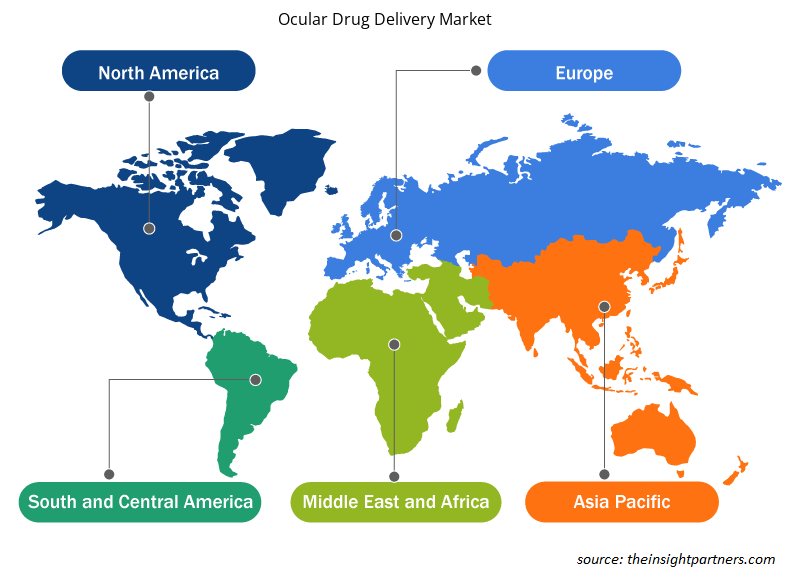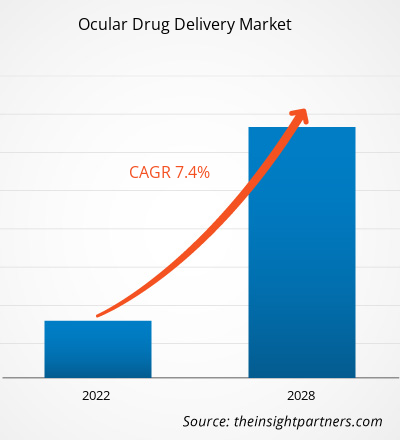2021 年眼部药物输送市场价值为 164.0432 亿美元,预计到 2028 年将达到 270.162 亿美元;预计 2021 年至 2028 年的复合年增长率为 7.4%。 CAGR of 7.4 % from 2021 to 2028.
眼部药物输送系统 (ODDS) 是一种剂型、载体或系统,用于向眼部滴注、给药或输送药物/药品,以治疗涉及或影响视力的任何疾病或病症。它包括用于眼表的简单无菌眼药水,以及用于眼内组织的复杂植入物。眼部药物制剂主要为液体形式,例如用于治疗前眼段疾病的溶液、悬浮液和乳剂。这些制剂可以采用先进的药物输送系统的形式,例如原位凝胶、微乳剂、纳米颗粒、脂质体、离子电渗疗法、纳米悬浮液和眼部插入物。 intraocular tissue. Ocular drug formulations are primarily liquid forms, such as solutions, suspensions, and emulsions for treating anterior eye segment diseases. These formulations can be available in the form of advanced drug delivery systems like in-situ gel, microemulsion, nanoparticle, liposome, iontophoresis, nanosuspension, and ocular inserts.
眼部给药市场根据技术、配方类型、疾病类型、最终用户和地理位置进行了细分。按地理位置划分,市场主要分为北美、欧洲、亚太地区、中东和非洲以及南美和中美洲。该报告提供了对眼部给药市场的见解和深入分析,强调了市场趋势、技术进步和市场动态等参数,以及全球领先市场参与者的竞争格局分析。
定制此报告以满足您的需求
您可以免费定制任何报告,包括本报告的部分内容、国家级分析、Excel 数据包,以及为初创企业和大学提供优惠和折扣
- 获取此报告的关键市场趋势。这个免费样品将包括数据分析,从市场趋势到估计和预测。
市场洞察
眼部疾病患病率不断上升,推动眼部药物输送市场增长
全球失明或视力低下的主要原因是白内障、青光眼、老年性黄斑变性、糖尿病视网膜病变和未得到解决的屈光不正。全球大多数人口一生中都患有或曾患有某种眼部疾病。根据世界卫生组织 (WHO) 于 2021 年 2 月发布的《失明和视力障碍》报告,全球约有 22 亿人患有近视或远视障碍。据估计,视力丧失或视力低下的主要原因是白内障(9400 万)和未矫正的屈光不正(8840 万)。此外,视力丧失的其他常见原因包括青光眼(770 万)、角膜混浊(420 万)、糖尿病视网膜病变(390 万)和沙眼(200 万)。
根据美国国家眼科研究所 (NEI) 的数据,到 2050 年,美国患有白内障的人数预计将从 2010 年的 2440 万增加一倍,达到约 5000 万。同样,根据《青光眼:2019 年事实与数据》报告,美国有超过 300 万人患有青光眼。此外,根据 2017 年加拿大残疾人调查,150 万加拿大人视力丧失,约 559 万人患有眼疾,这可能导致视力丧失。
此外,根据英国皇家盲人协会 2017 年的统计数据,在英国,约有 35 万人登记为盲人和视力不佳者;约有 173,735 人登记为视力严重受损者;176,125 人登记为视力受损者。
基于技术的见解
根据技术,眼部给药市场细分为植入式眼部给药系统、颗粒给药系统、纳米颗粒给药系统等。植入式眼部给药系统细分市场将在 2021 年占据最大的市场份额,预计该细分市场在预测期内的复合年增长率最高。
基于配方类型的洞察
根据配方类型,眼部给药市场细分为脂质体和纳米颗粒、溶液、乳液、悬浮液和软膏。溶液部分将在 2021 年占据最大的市场份额,预计在 2021-2028 年期间将实现最高的复合年增长率。溶液部分的增长归因于眼部给药系统以溶液形式(如眼药水和注射剂)的日益普及。
基于疾病类型的见解
根据疾病类型,眼部给药市场细分为青光眼、糖尿病视网膜病变、干眼症、黄斑变性、白内障、糖尿病性黄斑水肿等。白内障细分市场将在 2021 年占据最大的市场份额。预计该细分市场的复合年增长率将在 2021 年至 2028 年期间达到最高。
基于最终用户的洞察
根据最终用户,眼部给药市场分为医院、眼科诊所和门诊手术中心。医院部分将在 2021 年占据最大的市场份额,而眼科诊所部分预计在预测期内实现最高的复合年增长率。
COVID-19 疫情已成为全球面临的最大挑战。由于此次疫情给全球医疗系统带来压力,优先利用有限的资源对于减少住院人数至关重要。然而,尽管眼药水、眼药膏和眼药水混悬液等眼科治疗产品的需求增加,但随着新消费者进入市场,这些产品出现短缺。由于供应限制,制造商还面临价格上涨和原材料短缺的问题。然而,随着限制解除和企业恢复营业,供需变量正在恢复正常。这将为眼科药物输送治疗提供多种增长前景。
收购、合作、伙伴关系、产品发布和扩张是公司扩大其全球业务范围并满足不断增长的需求的常用策略。眼部给药市场参与者主要采用产品创新策略来满足全球不断变化的客户需求,这也有助于他们在全球范围内维护其品牌名称。
眼部给药市场区域洞察
Insight Partners 的分析师已详细解释了预测期内影响眼部给药市场的区域趋势和因素。本节还讨论了北美、欧洲、亚太地区、中东和非洲以及南美和中美洲的眼部给药市场细分和地理位置。

- 获取眼部药物输送市场的区域特定数据
眼部药物输送市场报告范围
| 报告属性 | 细节 |
|---|---|
| 2021 年市场规模 | 164亿美元 |
| 2028 年市场规模 | 270.2亿美元 |
| 全球复合年增长率(2021 - 2028) | 7.4% |
| 史料 | 2019-2020 |
| 预测期 | 2022-2028 |
| 涵盖的领域 | 按技术分类
|
| 覆盖地区和国家 | 北美
|
| 市场领导者和主要公司简介 |
|
眼部给药市场参与者密度:了解其对业务动态的影响
眼部给药市场正在快速增长,这得益于终端用户需求的不断增长,而这些需求又源于消费者偏好的不断变化、技术进步以及对产品优势的认识不断提高等因素。随着需求的增加,企业正在扩大其产品范围,进行创新以满足消费者的需求,并利用新兴趋势,从而进一步推动市场增长。
市场参与者密度是指在特定市场或行业内运营的企业或公司的分布情况。它表明在给定市场空间中,相对于其规模或总市场价值,有多少竞争对手(市场参与者)存在。
在眼部药物输送市场运营的主要公司有:
- 艾伯维公司(AbbVie Inc.)
- 博士伦保健公司
- 台湾脂质体股份有限公司
- 眼科治疗公司
- GRAYBUG VISION, INC.
免责声明:上面列出的公司没有按照任何特定顺序排列。

- 了解眼部药物输送市场顶级关键参与者概览
公司简介
- 艾伯维公司(AbbVie Inc.)
- 博士伦保健公司
- 台湾脂质体股份有限公司
- 眼科治疗公司
- GRAYBUG VISION, INC.
- Alimera Sciences, Inc.
- Envisia治疗公司
- 诺华公司
- 艾盖特制药公司
- Clearside 生物医学有限公司
- 历史分析(2 年)、基准年、预测(7 年)及复合年增长率
- PEST 和 SWOT 分析
- 市场规模价值/数量 - 全球、区域、国家
- 行业和竞争格局
- Excel 数据集


- Intradermal Injection Market
- Visualization and 3D Rendering Software Market
- Electronic Shelf Label Market
- Dry Eye Products Market
- Fish Protein Hydrolysate Market
- Artwork Management Software Market
- Energy Recovery Ventilator Market
- Social Employee Recognition System Market
- Analog-to-Digital Converter Market
- Medical Collagen Market

Report Coverage
Revenue forecast, Company Analysis, Industry landscape, Growth factors, and Trends

Segment Covered
This text is related
to segments covered.

Regional Scope
North America, Europe, Asia Pacific, Middle East & Africa, South & Central America

Country Scope
This text is related
to country scope.
常见问题
The factors that are restraining the adoption of ocular drug delivery are several disadvantages associated with ocular drug delivery.
The Ocular drug delivery market majorly consists of the players such as players AbbVie Inc., Bausch Health Companies Inc., Taiwan Liposome Company, Ltd., Ocular Therapeutix, Inc., Graybug Vision, Inc., Alimera Sciences, Inc., Envisia Therapeutics, Novartis AG, EyeGate Pharmaceuticals, Inc, Clearside Biomedical, Inc. and among others.
The factors that are driving growth of the market are growing prevalence of eye disorders and rising research on ocular drug delivery.
Ocular drug delivery system (ODDS) is a dosage form, vehicle, or system intended for instilling, administering, or delivering drug/medicine to eye against any ailment or disorder involving or affecting vision. It ranges from simple sterile eye drop for the ocular surface to complex implants for intraocular tissue. Ocular drugs formulations are primarily available in liquid form such as solutions, suspensions, and emulsions for treating anterior eye segment diseases. These formulations can be available in the form of advanced drug delivery systems like in-situ gel, microemulsion, nanoparticle, liposome, iontophoresis, nanosuspension, and ocular inserts.
Trends and growth analysis reports related to Life Sciences : READ MORE..
The List of Companies - Ocular Drug Delivery Market
- AbbVie Inc.
- Bausch Health Companies Inc.
- Taiwan Liposome Company, Ltd.
- Ocular Therapeutix, Inc.
- GRAYBUG VISION, INC.
- Alimera Sciences, Inc.
- Envisia Therapeutics
- Novartis AG
- EYEGATE PHARMACEUTICALS, INC
- Clearside Biomedical, Inc.
The Insight Partners performs research in 4 major stages: Data Collection & Secondary Research, Primary Research, Data Analysis and Data Triangulation & Final Review.
- Data Collection and Secondary Research:
As a market research and consulting firm operating from a decade, we have published and advised several client across the globe. First step for any study will start with an assessment of currently available data and insights from existing reports. Further, historical and current market information is collected from Investor Presentations, Annual Reports, SEC Filings, etc., and other information related to company’s performance and market positioning are gathered from Paid Databases (Factiva, Hoovers, and Reuters) and various other publications available in public domain.
Several associations trade associates, technical forums, institutes, societies and organization are accessed to gain technical as well as market related insights through their publications such as research papers, blogs and press releases related to the studies are referred to get cues about the market. Further, white papers, journals, magazines, and other news articles published in last 3 years are scrutinized and analyzed to understand the current market trends.
- Primary Research:
The primarily interview analysis comprise of data obtained from industry participants interview and answers to survey questions gathered by in-house primary team.
For primary research, interviews are conducted with industry experts/CEOs/Marketing Managers/VPs/Subject Matter Experts from both demand and supply side to get a 360-degree view of the market. The primary team conducts several interviews based on the complexity of the markets to understand the various market trends and dynamics which makes research more credible and precise.
A typical research interview fulfils the following functions:
- Provides first-hand information on the market size, market trends, growth trends, competitive landscape, and outlook
- Validates and strengthens in-house secondary research findings
- Develops the analysis team’s expertise and market understanding
Primary research involves email interactions and telephone interviews for each market, category, segment, and sub-segment across geographies. The participants who typically take part in such a process include, but are not limited to:
- Industry participants: VPs, business development managers, market intelligence managers and national sales managers
- Outside experts: Valuation experts, research analysts and key opinion leaders specializing in the electronics and semiconductor industry.
Below is the breakup of our primary respondents by company, designation, and region:

Once we receive the confirmation from primary research sources or primary respondents, we finalize the base year market estimation and forecast the data as per the macroeconomic and microeconomic factors assessed during data collection.
- Data Analysis:
Once data is validated through both secondary as well as primary respondents, we finalize the market estimations by hypothesis formulation and factor analysis at regional and country level.
- Macro-Economic Factor Analysis:
We analyse macroeconomic indicators such the gross domestic product (GDP), increase in the demand for goods and services across industries, technological advancement, regional economic growth, governmental policies, the influence of COVID-19, PEST analysis, and other aspects. This analysis aids in setting benchmarks for various nations/regions and approximating market splits. Additionally, the general trend of the aforementioned components aid in determining the market's development possibilities.
- Country Level Data:
Various factors that are especially aligned to the country are taken into account to determine the market size for a certain area and country, including the presence of vendors, such as headquarters and offices, the country's GDP, demand patterns, and industry growth. To comprehend the market dynamics for the nation, a number of growth variables, inhibitors, application areas, and current market trends are researched. The aforementioned elements aid in determining the country's overall market's growth potential.
- Company Profile:
The “Table of Contents” is formulated by listing and analyzing more than 25 - 30 companies operating in the market ecosystem across geographies. However, we profile only 10 companies as a standard practice in our syndicate reports. These 10 companies comprise leading, emerging, and regional players. Nonetheless, our analysis is not restricted to the 10 listed companies, we also analyze other companies present in the market to develop a holistic view and understand the prevailing trends. The “Company Profiles” section in the report covers key facts, business description, products & services, financial information, SWOT analysis, and key developments. The financial information presented is extracted from the annual reports and official documents of the publicly listed companies. Upon collecting the information for the sections of respective companies, we verify them via various primary sources and then compile the data in respective company profiles. The company level information helps us in deriving the base number as well as in forecasting the market size.
- Developing Base Number:
Aggregation of sales statistics (2020-2022) and macro-economic factor, and other secondary and primary research insights are utilized to arrive at base number and related market shares for 2022. The data gaps are identified in this step and relevant market data is analyzed, collected from paid primary interviews or databases. On finalizing the base year market size, forecasts are developed on the basis of macro-economic, industry and market growth factors and company level analysis.
- Data Triangulation and Final Review:
The market findings and base year market size calculations are validated from supply as well as demand side. Demand side validations are based on macro-economic factor analysis and benchmarks for respective regions and countries. In case of supply side validations, revenues of major companies are estimated (in case not available) based on industry benchmark, approximate number of employees, product portfolio, and primary interviews revenues are gathered. Further revenue from target product/service segment is assessed to avoid overshooting of market statistics. In case of heavy deviations between supply and demand side values, all thes steps are repeated to achieve synchronization.
We follow an iterative model, wherein we share our research findings with Subject Matter Experts (SME’s) and Key Opinion Leaders (KOLs) until consensus view of the market is not formulated – this model negates any drastic deviation in the opinions of experts. Only validated and universally acceptable research findings are quoted in our reports.
We have important check points that we use to validate our research findings – which we call – data triangulation, where we validate the information, we generate from secondary sources with primary interviews and then we re-validate with our internal data bases and Subject matter experts. This comprehensive model enables us to deliver high quality, reliable data in shortest possible time.


 获取此报告的免费样本
获取此报告的免费样本